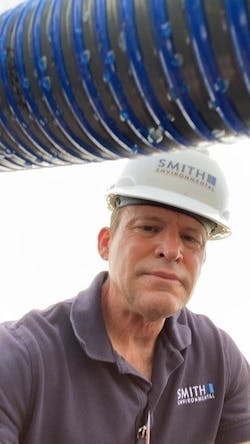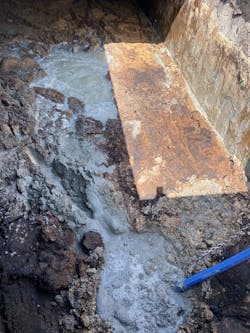About the author:
Chris French is a freelance writer on water, environment and renewable energy issues. French can be reached at [email protected].
Throughout Ohio there is a large a number of meat and food processing plants and municipal sites whose wastewater system is plagued by fats, oils, greases (FOG) and debris. Many of these may already have some sort of pump or mixer — perhaps sold on the basis of it being non-clog — but staring down at a tank crusted over so badly that wastewater cannot be seen, is an immediately tell that this is not the case. Chances are that the odor from the tank and collection system is so bad that even a new visitor to site — blindfolded — could locate it in seconds.
A classic example of this came to light when a leading meat processor — bogged down by reoccurring costs, foul odors and poor performance of its wastewater treatment system — looked for a cost-effective, long-term solution. The problem at this particular site was so bad that one could (not that anyone in their right mind would) walk on or jump up and down on the layer of the tank’s crust because it was so thick.
To combat the ongoing crust, odor problem and loss of capacity in its 300,000-gallon equalization tank, the meat processor considered the use of chemicals to tackle the wastewater, and was also trying to get things moving in the tank by hiring a contractor four times a year to blast the crust apart with a basic portable pump. This rather primitive, nasty job not only caused a temporary major increase in odors, but also cost $5,000 per visit.
As with all meat and food processors, wash-down of the plant at the end of the work day presents a test for the on-site wastewater treatment system — in this case two dissolved air floatation (DAF) units as they suddenly have to deal with bringing a large volume of particles to the surface. Fat removal is essential for discharge consent, to protect the local water courses en route to the local municipal wastewater treatment facility, and to keep effluent costs as low as possible.
At this Ohio plant, removed fat also provides a revenue stream as it is sold on for use in other manufacturing industries.
Finally, with the odor-generating permanent presence of fat in the equalization tank and a lack of capacity adversely affecting the whole treatment process led the meat plant’s facilities manager — who described the situation as “extremely troublesome; especially the odors” — to seek help via his chemical vendor.
An inquiry was made to Smith Environmental, initially for a propeller mixer, but upon learning more about the tough application, the Columbus-based wastewater consultant knew immediately that a more robust solution would be required.
“Never Seen a Tank So Crusted Up”
“Over the years we’ve seen some very clogged up lift stations,” said Paul Matrka of Smith Environmental. “Every municipality across America seems to have at least one very labor-intensive sewage lift station that causes major problems, but while all meat processors have the same issue with waste fat to deal with, I have to admit that in this case, in my over 25 years’ experience in the industry, I’ve never seen a tank so crusted up.”
Representing a carefully selected range of equipment from top-line manufacturers, Smith Environmental had experienced positive outcomes with a chopper pump that not only has an external knife system to prevent solids from entering its casing, but one that — when fitted with a Venturi nozzle — acts as an effective mixer to distribute air throughout the tank.
In keeping with its firm policy of designs driven with what is the best long-term solution for the community, Smith Environmental proposed a trial of the AeriGator from Landia.
Bubbles Bust Up the Crust
“We were confident,” said Matrka, “but with the crust being so thick at the time, we had to try almost 20 times for more than 15 minutes to get the AeriGator in low enough through the thick layer – and to make sure that we were all out of harm’s way. When the scum began to blow out of the nozzle, it was really disgusting – unless you happen to have a liking for thick brown toothpaste!
“As bubbles began to emerge and the crust slowly began to break up, we could see that it was working. The facilities manager was suitably amazed at what this set-up could do. And despite what I’ve said about trying to lower it down, installation of the AeriGator is actually very easy; an operator could set up themselves in an afternoon”.
Such was the speed and efficiency of the new equipment that wisely, Smith Environmental held back on clearing all of the tank’s crust at once, so as not to overwhelm the DAF plants, with what would have been a long continuous slug of fat.
Some fine-tuning of the operation is still in progress, but now that the crust is no longer present, the meat processor’s DAFs receive a far more consistent flow from the now blended equalization tank. This allows discharge consent for final effluent to be met without the previous variations also caused by the fluctuations of the chemicals that were being added to combat the bad odors.
“The acquisition of just this one pump will make a big positive difference to the bottom line at the meat processor,” Matrka added.
Although there were not any significant complaints about the smell, addressing it before it became a problem was crucial. The unit is now running 24/7 and addresses the problem without an issue.
“Our Facilities Manager customer is now such a champion of this product that every time I see or talk with him, he’s selling its benefits to me. It’s made a huge difference to the plant,” Matrka said.
About the Author
Chris French
Chris French is a freelance writer on water, environment and renewable energy issues. French can be reached at [email protected].

